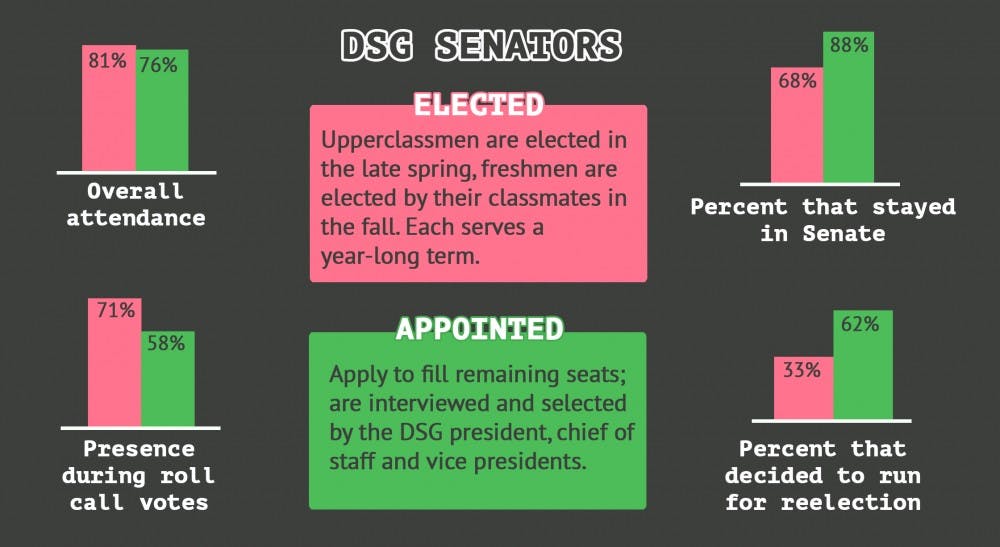Elected Duke Student Government senators attend meetings slightly more frequently than appointed at-large senators, but are less likely to run for another term.
The student body votes for elected senators late in the Spring semester and freshmen vote for freshman senators at the beginning of the Fall to serve a year-long term. All other senators are appointed through the at-large process, in which the president, the chief of staff and the vice presidents interview applicants to fill remaining seats in the Senate. After last week’s election, 19 seats remain vacant and will have to be filled through the at-large process.
This year, elected senators have an average attendance rate of 80.9 percent and appointed senators have an average attendance rate of 75.9 percent, according to DSG’s public attendance records as of Tuesday evening. Approximately 71 percent of elected senators have been present for roll-call votes—recorded votes at the request of senators—this academic year, compared to 57.5 percent of appointed senators.
“A lot of people say that they just don’t want to spend hours upon hours every week in the Senate,” said freshman Adam Bullock, an appointed senator for equity and outreach.
Despite their slightly higher attendance rates, elected senators are more likely than at-large senators to step down before the end of the year or choose not to run for a second term.
Only 67.7 percent of elected senators are still in the Senate compared to 88.2 percent of this year’s appointed senators.
In the most recent election, 33.3 percent of elected senators ran, compared to 61.8 percent of appointed senators.
“We see higher retention for at-large senators because to a certain extent, being a senator favors the type of person we see apply at large,” wrote DSG Attorney General Annie Adair, a junior, in an email. “Running an election requires a certain type of boisterousness and a lot more work depending on the position, which is a turn off for a lot of people. Many will opt out of the election process, knowing that they can avoid it altogether and just apply at large in the Fall.”
In addition to elected and appointed senators, DSG Senate has ad-hoc senators, who are not required to attend senate meetings and solely work for their appointed committee.
Despite this difference, Bullock noted that ad-hoc senators often feel just as effective as senators who are required to attend meetings.
Sophomore Taylor Panzer was elected last Spring as a senator for academic affairs. However, she no longer serves in that capacity and is instead an ad hoc senator for academic affairs.
“After the Fall as a full senate member, I became an ad-hoc senator for academic affairs as I realized my skill set was better suited and I was more passionate about creating and planning programs for students and faculty rather than being a voting member of the Senate,” Panzer wrote in an email.
Some students cite other reasons for choosing to leave the Senate during the year.
Junior Zoe Bakker, a former senator for residential life, wrote in an email that she chose not to continue in the Senate because she decided to study abroad this semester.
Of the 12 senators that currently have three or more unexcused absences, from both not being present at meetings or from leaving meetings early, 10 are appointed. One of the appointed senators is sophomore Riyanka Ganguly, an appointed senator for equity and outreach and the vice president-elect for equity and outreach.
As was the case regarding previous Chronicle questions about senator attendance, Ganguly noted in an email that she did not think the attendance record was accurate.
“There was a lot of confusion with changing of secretaries, and I don’t think that is accurate. I’m not sure why that is the case, especially since I clarified things with [Executive Vice President John] Guarco,” Ganguly wrote.
Guarco previously noted that attendance inconsistencies were due to a switch in executive secretaries, who are responsible for keeping track of the attendance and voting records.
Even though elected senators have a better attendance record overall than appointed senators, Executive Vice President-elect Ilana Weisman, a junior, noted that during the recent debate on restructuring the Senate, only 11 of the 21 elected senators were present at the meeting.
“We see higher turnover of freshmen elected senators especially from the fall to the spring,” Adair wrote. “This can be for a variety of reasons, including more commitments second semester, realizing that senate just wasn’t what they thought it would be, and choosing to pursue other activities. This happens every year.”
Get The Chronicle straight to your inbox
Signup for our weekly newsletter. Cancel at any time.
Class of 2019
Editor-in-chief 2017-18,
Local and national news department head 2016-17
Born in Hyderabad, India, Likhitha Butchireddygari moved to Baltimore at a young age. She is pursuing a Program II major entitled "Digital Democracy and Data" about the future of the American democracy.

